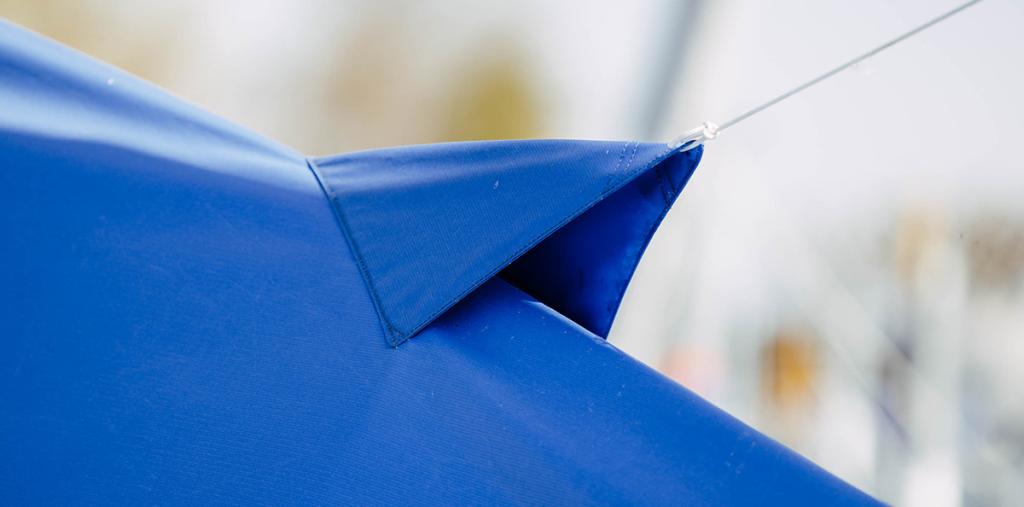


PLANOFIL® is the proven market leader in many functional categories and is therefore the tarpaulin of choice
Top quality "Made in Switzerland" – and it's no empty phrase, it refers to a material with functions that have been stringently tested and found to be outstanding. We have subjected PLANOFIL® to test procedures both internally and externally. This means that the results of other products on the market can be legitimately compared and our tarpaulin comes out with the best scores in a comparison.
From weight to tear-resistance through to the water column and beading effect, we look at a range of functional categories and demonstrate the particular strengths and advantages of PLANOFIL®.
PLANOFIL® – the unbeatable outdoor material: Lightweight, tear-resistant, robust and durable, abrasion-resistant, UV-resistant, sustainable
The weight of the tarpaulin is very important in terms of handling in particular, but the lightweight characteristics must not impact its durability. We have found the perfect balance for PLANOFIL®: At 190 g/m2, our tarpaulin material weighs very little and can therefore be easily moved, stored and even processed. At the same time, the material is extremely robust – a quality that is proven, for example, by the top scores it achieves in the tear propagation resistance category.
Fabrics subjected to heavy-duty use (primarily in outdoor areas, for example for covers, sails and awnings) require a high level of tear propagation resistance so that they do not tear any further after being cut or nicked. PLANOFIL® ranks number one in tests to determine the tear propagation resistance of textile fabrics (standard: ISO 13937-1).
PLANOFIL® also achieves top results when it comes to tear resistance (the force required to make a tear in a material under certain conditions). This means that our tarpaulin material can reliably withstand strong tension and extreme weather conditions. Standard: ISO 13934-1
The term "weathering" is inevitably associated with moisture. To protect against this, outdoor tarpaulin material should have the best possible water-repellent properties. In a corresponding spray test (which involves pouring water through a nozzle on to the test specimen at a defined distance) in accordance with the ISO 4920 standard, PLANOFIL® achieves the maximum score of 100.
The water penetration of a material is determined – usually in mm – with the water column as the reference value, which is commonly used in the outdoor sector. This specifies the pressure that a fabric can withstand before water starts to pass through. Here, a water column of 1000 mm corresponds roughly to a pressure of 0.1 bar. With a water column of at least 2000 mm, PLANOFIL® achieves the second highest value in a comparison and therefore offers excellent protection against moisture penetration. Standard: ISO 811
The Bundesmann water absorption test (ISO 9865 standard) calculates the percentage of water absorbed by the material over a period of 60 minutes. With a result of around 12%, PLANOFIL® is significantly ahead of the competition and offers the best water-repellent properties in this respect.
The beading effect, which indicates the water-repellent properties of fabrics, is determined according to the Bundesmann test (ISO 29865 standard) by simulating a tropical rain shower. PLANOFIL® comes out top in this category too, which means that water runs off or beads on our tarpaulin material extremely well instead of collecting on it and penetrating it after a certain amount of time.
Outdoor materials not only need to be able to withstand weather conditions and heavy-duty use, normal everyday use also causes wear on the fabric depending on its properties: The higher the resistance to abrasion, the more robust and durable the fabric is. It also remains visually appealing for longer. The Martindale method simulates the everyday use of a material by rubbing it mechanically against a second material (wool fabric) using a weight until the test material is completely worn (at least two threads have broken). As the market leader, PLANOFIL® achieves the maximum measured score of 100,000 cycles. Standard: ISO 12947-2
If a fabric is dyed or printed, this special characteristic should last as long as possible. The colour fastness test (ISO 105/X12 standard: Colour fastness against rubbing) determines the resistance of and changes to a dyed/printed fabric subjected to external influences. The test involves rubbing this fabric mechanically against both a dry and a wet adjacent fabric. PLANOFIL® achieves top marks in both cases.
UV protection plays an important role when it comes to the protective properties of a material. Measured in accordance with the ISO 13758-1 standard, the value (generally using the abbreviation UPF: Ultraviolet Protection Factor) indicates how much UV radiation the fabric lets through. With a high UPF of 50+, PLANOFIL® blocks out at least 98% of UV radiation and is therefore also one of the market leaders in this category.
The quality of a material should not only be measured by its functional properties, but should also be based on its durability (an important factor with regards to sustainability) and on the environmental aspects that play a role in its manufacture. In addition to its long service life and durability, PLANOFIL® has been awarded the following environmental certificates :
- STeP by OEKO-TEX®
- ISO 9001:2015 and ISO 14001:2015
Contact
PLANOFIL | Senfa Cilander Switzerland AG
Cilanderstrasse 20
9100 Herisau
SWITZERLAND
Newsletter subscription
May we keep you updated?